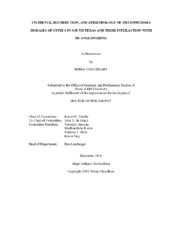| dc.description.abstract | Foot rot, gummosis and root rot disease caused by Phytophthora are major constraints for commercial citrus production in the Lower Rio Grande Valley (LRGV), Texas. Not much is known about the extent of foot rot and gummosis incidence, severity, and characteristics of the Phytophthora species found in the commercial citrus orchards in the LRGV. To further elucidate the epidemiology of Phytophthora-caused foot rot and gummosis in the commercial citrus orchards of Texas, a survey of 30 orchards was conducted in 2015 and 2017. Foot rot lesions were detected in 33% of the trees surveyed and disease severities measured in 2015 and 2017 were 14.2 and 15.9% respectively. P. nicotianae was found to be the most prevalent species as all 89 Phytophthora isolates obtained from plant and soil samples collected from citrus orchards were identified as P. nicotianae.
Twenty-nine percent and 71% of these isolates were determined to be A1 and A2 mating types, respectively and the presence of both mating types was confirmed in three orchards. Among the tested isolates from the LRGV, none were found to be mefenoxam resistant, but the EC50 value for one isolate from Corpus Christi measured 143 μg/ml. The other objective was to study the effect of the interaction of foot rot and gummosis disease in Candidatus Liberibacter asiaticus (CLas) positive trees on the root health, nutrient status and canopy thinning. To evaluate this, 46 CLas positive and negative trees with and with-out foot rot from four grapefruit orchards in Donna, Texas in 2014 and 2016 were studied.
The presence of CLas and foot rot disease was associated with significantly altered levels of sodium, copper, and sulfur in the symptomatic leaves and greater canopy thinning. Foot rot significant effect was observed on lowering root density, while CLas was
associated with significant increases in starch, sucrose, and glucose, and significantly reduced phosphorus and magnesium in the symptomatic leaves.
The existence of a mefenoxam resistant isolate in the Corpus Christi and the identification of both mating types in the two orchards in the LRGV means that new strains could arise and present control challenges. The presence of both CLas and foot rot resulting in canopy thinning and potential tree decline emphasizes the need for continued control of Phytophthora. | en |


